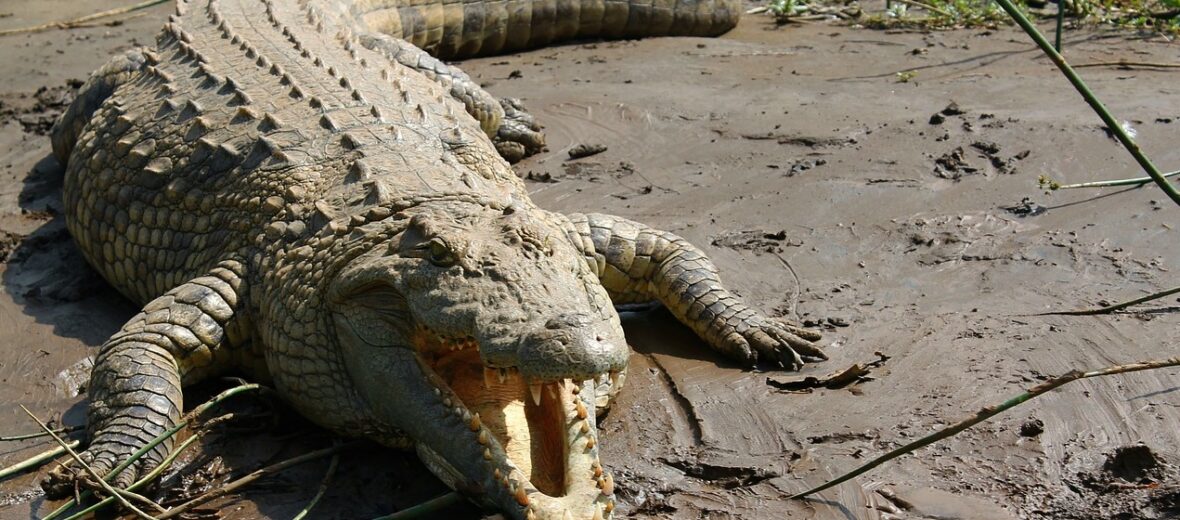
The Nile crocodile is among the most widely respected and feared animals in Africa. They can be single minded, fast, powerful, & worth respecting. After the saltwater crocodile, the Nile is the second largest and the largest reptile, by far, in all of Africa. Nile crocs are typically always in the top 5 most lethal animals on the African continent. With an estimated 70,000 wild individuals, these prehistoric beasts are listed as Least Concern by the IUCN. Even though they suffer from habitat loss, pollution, hunting, and climate change.
First the Stats…
Scientific name: Crocodylus niloticus
Weight: Up to 1,700 lbs.
Length: Up to 14+ feet
Lifespan: Up to 100 years
Now on to the Facts!
1.) The crocodile is on record as having the strongest bite force of any animal. The Nile croc’s bite is 8x stronger than that of a great white shark and 12x more powerful than a mastiff’s!
2.) Like all crocodillians though, the muscles used to open their powerful jaws are in stark contrast to the muscles used to snap them shut. You can literally hold their jaws shut with your bare hands.
3.) Crocodiles are considered by many to be the most vocal of all reptiles. They emit around 5 different sounds, from the ultrasonic bellowing sound that can be heard from great distances to the peeping sound made by juveniles, calling to their mother to help excavate them from the nest.
4.) Due to a specially evolved palatal valve, located at the back of their throat, these crocs can move about under water with their mouth open, snatch up and even hold their prey without ever ingesting any water.
5.) They can be found in Sub-Saharan Africa in large freshwater lakes, freshwater swamps, mangrove swamps, rivers, and coastal estuaries. They can also be found in western Madagascar in similar habitats.
But wait, there’s more on the Nile crocodile!
6.) Typically solitary, they can be found in smaller groups called a bask, float, congregation, or a nest.
7.) Nile crocs are nocturnal (active at night) and spend their days either cooling off in water or basking in the sun.
Did you know…?
These beasts may look slow and awkward on land, but they can swim up to 22 mph!
8.) When feeding, in small congregations, they stick to a hierarchy where the largest and more dominant crocodiles eat first.
9.) These crocodiles can stay submerged for up to 30 minutes at a time. However, they are capable of holding their breath for up to 2 hours, if necessary.
10.) Nile crocodiles go by other names too, such as Garwe, Mamba, and Ngwenya.
But wait, there’s still more on the Nile crocodile!
11.) Their scientific name of Crocodylus is derived from the Greek krokodeilos which means quite literally translates to “pebble worm”. Their secondary name niloticus translates to “of the Nile”.
12.) They prey on insects & amphibians (when young), fish and land mammals like giraffes, buffaloes, antelope, zebras, birds, carrion (rotting flesh), and any other unsuspecting animal or human that stops by the ole watering hole for a drink of tasty brown water.
Did you know…?
Ancient Egyptian tombs have yielded Nile crocodile corpses and eggs.
13.) Niles are polygamous (1 male mates with several females).
14.) Females lay up to 80 eggs, high up from the shoreline. The female will then guard the eggs, as they incubate for up to 90 days.
15.) Once the eggs are ready to hatch, the juveniles will call to their mother to dig them from their earthen nest.
But wait, there’s still a little more on the Nile crocodile!
16.) Once the female opens the nest, she will carry her baby crocs, in her mouth, to a crèche to join other juvenile crocs. The females will continue to guard their young till they start venturing out on their own. This takes up to 2 years.
17.) The gender of the crocodile hatchlings is calculated by the temperatures at which the eggs incubate. At 86ºF and lower the juveniles will be predominantly female; at 87.8ºF there will be both male and females born; and at 89.6ºF, the young will be primarily male.
Did you know…?
Large Nile crocodiles will swallow stones, called gastroliths. These serve as a ballast, aiding them in balancing their body underwater.
18.) While in the crèche, if the juveniles are threatened, mom will scoop them up in her gular (throat) pouch and carry them to safety.
19.) Both mom and dad help the hatchlings emerge from the eggs; they roll the eggs between their tongue and palate, thus cracking the egg’s shell allowing for an easier escape.
20.) Only juveniles have predators. Adults have no natural predators, sans humans.
Now a Short Nile Crocodile Video!
Also, check out the Critter Science YouTube channel. Videos added frequently!
Want to suggest a critter for me to write about? Let me know here.



